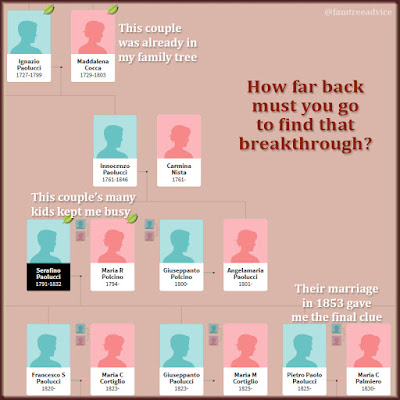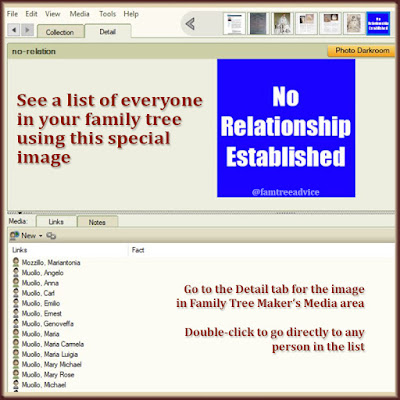Is there a hidden meaning behind the last names in your family tree?
You may know where your recent ancestors came from. You may even know where your much earlier ancestors came from. But do you know the origins of their last names?
You may call it a last name, a family name, or a surname. In Italian it's un cognome. In Spanish, un apellido.
Last names fall into a few different categories and can give you a clue about their background.
 |
| Are your last names tied to a particular place? |
Do your ancestral last names fit into these categories?
- Monogenetic—A name that began with one family in one place. My grandfather's last name, for example, has its roots almost exclusively in one town in Italy. How lucky for me!
- Polygenetic—A name used at different times, in different places, by different families. My other grandfather's last name is ridiculously common and found in every part of Italy.
Those are general categories. Let's get more specific with these 4 types of last names:
- Place names—Hill, Dale, Ford, Rivers, as well as specific names of rivers, mountains, and towns
- Occupational names—Smith/Ferraro/Schmidt, Miller/Molinari/Mueller, Cooper/Bottaio, Weaver/Tessitore/Weber, Tailor/Sarti/Snyder, Shoemaker/Zapatero/Schumacher
- Patronymics—These are names with a beginning or ending that says who was your daddy.
- German: -sohn, -sen (Larsen, son of Lars)
- Irish: Mc-, Mac-, O'- (McDonald, son of Donald)
- Italian: d'-, di-, de-, li-, lo- (diFranco, son of Franco)
- Russian: -ev, -evsky, -ov, -ovich, -ovsky (one of my favorite authors is Fyodor Mikhailovich Dostoevsky; his middle name tells us his father was Mikhail)
- Spanish: -ez, -es, -is, -iz (Gonzalez, son of Gonzalo)
- Personal appearance and characteristic names. These include words for short, curly-haired, red-haired, fat, big, strong, kind. Animal names also fall into this category, such as Wolf/Lupo, Fox/Volpe.
There are also foundling names. These are the names given to babies usually born out of wedlock and abandoned to the care of the church.
- Spanish: Expósito, Iglesia, Cruz, Blanco
- Italian: Esposito, Proietti, Trovato, Casadio
Authorities might give a foundling baby boy the last name Esposito. But he will pass the name on to each of his children, and his sons will pass it on to their children. So don't assume each Esposito was a foundling.
Here's what it looks like when I apply these rules to some of my ancestors' last names.
- Caruso: A word meaning close-cropped hair, but also a term for a boy or young man.
- diPaola: A patronymic from the name Paolo (Paul), although in my family it's changed to Paola.
- Franza: From Franciscus, or someone who lives in France. We've got no French DNA, though.
- Iamarino: A patronymic from the name Giovanni Marino. The variation of Giammarino makes the Giovanni or Gianni clearer.
- Leone: The word for lion, but meaning the son of Leonardo.
- Petruccelli: A patronymic from the name Pietro (Peter).
- Pilla: Possibly from the Roman family name Pompilius. That'd be cool.
- Pisciotti: An occupational name from the word pesce, fish.
- Sarracino: From the Saracens—a non-Arab people living in the Arabian desert when it was a Roman province. Later, Saracen meant Muslim or Arabs.
- Saviano: From the Sabine people who lived in the Apennine Mountains of ancient Italy.
- Tedesco: The word for German.
- Valente: The word for talented.
 |
| The Saracens were an ancient people. Were my ancestors named for them? Erhard Reuwich "Sarazenen", 1486, Public domain |
I love that Saviano has ancient Italian roots. This is the last name of my 2nd great grandfather. He's my first ancestor to come to America. He made trips to New York and back in 1890, 1892, and 1895, then brought the rest of his family here in 1898.
In fact, my maternal grandmother's parents were a Sarracino (Saracen) and Saviano (Sabine). Their marriage may have been a union of two very ancient peoples. That could explain my mom's 100% Southern Italian DNA.
Learning their names and finding their hometowns is all I need to make me love genealogy. (See "Genealogy is the Joy of Names".)
 |
| How many last names do you descend from? |
Is there more history and meaning hidden in your ancestors' last names? Here are some resources from "Behind the Name" to help you understand the names in your family tree:
For a lot more types of names, visit the Behind the Names website.




